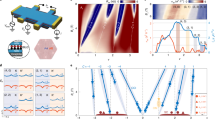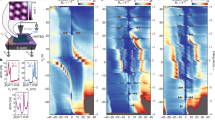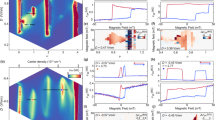Abstract
In magic-angle twisted bilayer graphene, the moiré superlattice potential gives rise to narrow electronic bands that support a multitude of many-body quantum phases. Further richness arises in the presence of a perpendicular magnetic field, where the interplay between moiré and magnetic length scales leads to fractal Hofstadter subbands. In this strongly correlated Hofstadter platform, multiple experiments have identified gapped topological and correlated states, but little is known about the phase transitions between them in the intervening compressible regimes. Here we simultaneously unveil sequences of broken-symmetry Chern insulators and resolve sharp phase transitions between competing states with different topological quantum numbers and different occupations of the spin-valley flavour. Our measurements determine the energy spectrum of interacting Hofstadter subbands in magic-angle twisted bilayer graphene and map out the phase diagram of flavour occupancy. In addition, we observe full lifting of the degeneracy of the zeroth Landau levels together with level crossings, indicating moiré valley splitting. We propose a unified flavour polarization mechanism to understand the intricate interplay of topology, interactions and symmetry breaking as a function of density and applied magnetic field in this system.
This is a preview of subscription content, access via your institution
Access options
Access Nature and 54 other Nature Portfolio journals
Get Nature+, our best-value online-access subscription
$29.99 / 30 days
cancel any time
Subscribe to this journal
Receive 12 print issues and online access
$209.00 per year
only $17.42 per issue
Buy this article
- Purchase on Springer Link
- Instant access to full article PDF
Prices may be subject to local taxes which are calculated during checkout




Similar content being viewed by others
Data availability
The data that support the findings of this study are available from the corresponding author upon reasonable request. Source data are provided with this paper.
Code availability
The codes that support the findings of this study are available from the corresponding author upon reasonable request.
References
Bistritzer, R. & MacDonald, A. H. Moiré bands in twisted double-layer graphene. Proc. Natl Acad. Sci. USA 108, 12233–12237 (2011).
Cao, Y. et al. Correlated insulator behavior at half-filling in magic-angle graphene superlattices. Nature 556, 80–84 (2018).
Cao, Y. et al. Unconventional superconductivity in magic-angle graphene superlattices. Nature 556, 43–50 (2018).
Yankowitz, M. et al. Tuning superconductivity in twisted bilayer graphene. Science 363, 1059–1064 (2019).
Lu, X. et al. Superconductors, orbital magnets and correlated states in magic-angle bilayer graphene. Nature 574, 653–657 (2019).
Sharpe, A. L. et al. Emergent ferromagnetism near three-quarters filling in twisted bilayer graphene. Science 365, 605–608 (2019).
Serlin, M. et al. Intrinsic quantized anomalous Hall effect in a moiré heterostructure. Science 367, 900–903 (2020).
Cao, Y. et al. Nematicity and competing orders in superconducting magic-angle graphene. Science 372, 264–271 (2021).
Zondiner, U. et al. Cascade of phase transitions and Dirac revivals in magic-angle graphene. Nature 582, 203–208 (2020).
Wong, D. et al. Cascade of electronic transitions in magic-angle twisted bilayer graphene. Nature 582, 198–202 (2020).
Saito, Y. et al. Isospin Pomeranchuk effect in twisted bilayer graphene. Nature 592, 220–224 (2021).
Rozen, A. et al. Entropic evidence for a Pomeranchuk effect in magic-angle graphene. Nature 592, 214–219 (2021).
Saito, Y. et al. Hofstadter subband ferromagnetism and symmetry-broken Chern insulators in twisted bilayer graphene. Nat. Phys. 17, 478–481 (2021).
Park, J. M., Cao, Y., Watanabe, K., Taniguchi, T. & Jarillo-Herrero, P. Flavour Hund’s coupling, Chern gaps and charge diffusivity in moiré graphene. Nature 592, 43–48 (2021).
Nuckolls, K. P. et al. Strongly correlated Chern insulators in magic-angle twisted bilayer graphene. Nature 588, 610–615 (2020).
Choi, Y. et al. Correlation-driven topological phases in magic-angle twisted bilayer graphene. Nature 589, 536–541 (2021).
Das, I. et al. Symmetry-broken Chern insulators and Rashba-like Landau-level crossings in magic-angle bilayer graphene. Nat. Phys. https://doi.org/10.1038/s41567-021-01186-3 (2021).
Wu, S., Zhang, Z., Watanabe, K., Taniguchi, T. & Andrei, E. Y. Chern insulators, van Hove singularities and topological flat bands in magic-angle twisted bilayer graphene. Nat. Mater. 20, 488–494 (2021).
Tomarken, S. L. et al. Electronic compressibility of magic-angle graphene superlattices. Phys. Rev. Lett. 123, 046601 (2019).
Pierce, A. et al. Unconventional sequence of correlated Chern insulators in magic-angle twisted bilayer graphene. Nat. Phys. 17, 1210–1215 (2021).
Xie, Y. et al. Spectroscopic signatures of many-body correlations in magic-angle twisted bilayer graphene. Nature 572, 101–105 (2019).
Kerelsky, A. et al. Maximized electron interactions at the magic angle in twisted bilayer graphene. Nature 572, 95–100 (2019).
Jiang, Y. et al. Charge order and broken rotational symmetry in magic-angle twisted bilayer graphene. Nature 573, 91–95 (2019).
Choi, Y. et al. Electronic correlations in twisted bilayer graphene near the magic angle. Nat. Phys. 15, 1174–1180 (2019).
Saito, Y., Ge, J., Watanabe, K., Taniguchi, T. & Young, A. F. Independent superconductors and correlated insulators in twisted bilayer graphene. Nat. Phys. 16, 926–930 (2020).
Stepanov, P. et al. Untying the insulating and superconducting orders in magic-angle graphene. Nature 583, 375–378 (2020).
Liu, X. et al. Tuning electron correlation in magic-angle twisted bilayer graphene using Coulomb screening. Science 371, 1261–1265 (2021).
Stepanov, P. et al. Competing zero-field Chern insulators in superconducting twisted bilayer graphene. Phys. Rev. Lett. 127, 197701 (2021).
Po, H. C., Zou, L., Vishwanath, A. & Senthil, T. Origin of Mott insulating behavior and superconductivity in twisted bilayer graphene. Phys. Rev. X 8, 031089 (2018).
Bultinck, N. et al. Ground state and hidden symmetry of magic-angle graphene at even integer filling. Phys. Rev. X 10, 031034 (2020).
Kang, J. & Vafek, O. Strong coupling phases of partially filled twisted bilayer graphene narrow bands. Phys. Rev. Lett. 122, 246401 (2019).
Liu, J., Liu, J. & Dai, X. Pseudo Landau level representation of twisted bilayer graphene: band topology and implications on the correlated insulating phase. Phys. Rev. B 99, 155415 (2019).
Lian, B. et al. Twisted bilayer graphene. IV. Exact insulator ground states and phase diagram. Phys. Rev. B 103, 205414 (2021).
Hofstadter, D. R. Energy levels and wave functions of Bloch electrons in rational and irrational magnetic fields. Phys. Rev. B 14, 2239–2249 (1976).
Bistritzer, R. & MacDonald, A. H. Moiré butterflies in twisted bilayer graphene. Phys. Rev. B 84, 035440 (2011).
Moon, P. & Koshino, M. Energy spectrum and quantum Hall effect in twisted bilayer graphene. Phys. Rev. B 85, 195458 (2012).
Hejazi, K., Liu, C. & Balents, L. Landau levels in twisted bilayer graphene and semiclassical orbits. Phys. Rev. B 100, 035115 (2019).
Zhang, Y.-H., Po, H. C. & Senthil, T. Landau level degeneracy in twisted bilayer graphene: role of symmetry breaking. Phys. Rev. B 100, 125104 (2019).
Lian, B., Xie, F. & Bernevig, B. A. Landau level of fragile topology. Phys. Rev. B 102, 041402 (2020).
Wannier, G. H. A result not dependent on rationality for Bloch electrons in a magnetic field. Phys. Status Solidi B 88, 757–765 (1978).
Uri, A. et al. Mapping the twist-angle disorder and Landau levels in magic-angle graphene. Nature 581, 47–52 (2020).
Eisenstein, J. P., Pfeiffer, L. N. & West, K. W. Negative compressibility of interacting two-dimensional electron and quasiparticle gases. Phys. Rev. Lett. 68, 674–677 (1992).
Zhou, H. et al. Half-and quarter-metals in rhombohedral trilayer graphene. Nature 598, 429–433 (2021).
Arora, H. S. et al. Superconductivity in metallic twisted bilayer graphene stabilized by WSe2. Nature 583, 379–384 (2020).
Bi, Z., Yuan, N. F. Q. & Fu, L. Designing flat bands by strain. Phys. Rev. B 100, 035448 (2019).
Parker, D. E., Soejima, T., Hauschild, J., Zaletel, M. P. & Bultinck, N. Strain-induced quantum phase transitions in magic-angle graphene. Phys. Rev. Lett. 127, 027601 (2021).
Huang, K. S., Han, Z., Kivelson, S. A. & Yao, H. Pair-density-wave in the strong coupling limit of the Holstein–Hubbard model. npj Quantum Mater. 7, 17 (2022).
Kang, J., Bernevig, B. A. & Vafek, O. Cascades between light and heavy fermions in the normal state of magic angle twisted bilayer graphene. Preprint at https://arxiv.org/abs/2104.01145 (2021).
Kennes, D. M. et al. Moiré heterostructures as a condensed-matter quantum simulator. Nat. Phys. 17, 155–163 (2021).
Chen, G. et al. Evidence of a gate-tunable Mott insulator in a trilayer graphene moiré superlattice. Nat. Phys. 15, 237–241 (2019).
Wang, L. et al. One-dimensional electrical contact to a two-dimensional material. Science 342, 614–617 (2013).
Acknowledgements
We thank D. Goldhaber-Gordon and O. Vafek for helpful discussions. This work was supported by the QSQM, an Energy Frontier Research Center funded by the US Department of Energy (DOE), Office of Science, Basic Energy Sciences (BES), under award no. DE-SC0021238. B.E.F. acknowledges a Stanford University Terman Fellowship and an Alfred P. Sloan Foundation Fellowship. K.W. and T.T. acknowledge support from the Elemental Strategy Initiative conducted by MEXT, Japan (grant no. JPMXP0112101001) and JSPS KAKENHI (grant no. JP20H00354). S.A.K. acknowledges support from the Department of Energy, Office of Basic Energy Sciences, under contract no. DEAC02-76SF00515. B.A.F. acknowledges a Stanford Graduate Fellowship. M.E.B. acknowledges support from the Marvin Chodorow Postdoctoral Fellowship of the Applied Physics Department, Stanford University. Y.S. was supported by the Gordon and Betty Moore Foundation’s EPiQS Initiative through grants GBMF 4302 and GBMF 8686. P.P. acknowledges partial support from NSF grant DMR-2111379. Part of this work was performed at the Stanford Nano Shared Facilities (SNSF), supported by the National Science Foundation under award ECCS-2026822.
Author information
Authors and Affiliations
Contributions
J.Y., B.A.F. and B.E.F. designed and conducted the scanning SET experiments. M.E.B. and Z.-X.S. designed and conducted the MIM experiments. B.A.F. fabricated the sample. Z.H., Y.S., S.A.K. and P.P. contributed to theoretical analysis. K.W. and T.T. provided hBN crystals. All authors participated in discussions and in writing of the manuscript.
Corresponding author
Ethics declarations
Competing interests
Z.-X.S. is a co-founder of PrimeNano Inc., which licensed the MIM technology from Stanford University for commercial instruments.
Peer review
Peer review information
Nature Physics thanks the anonymous reviewers for their contribution to the peer review of this work
Additional information
Publisher’s note Springer Nature remains neutral with regard to jurisdictional claims in published maps and institutional affiliations.
Extended data
Extended Data Fig. 1 Spatial dependence of electronic compressibility at zero field.
Linecut of dμ/dn as a function of gate voltage (Vg) measured along a line in the top left contact area of the device shown in Fig. 1a. The Landau fans shown in Fig. 1 and Extended Data Fig. 4 are taken at x = 40 nm and x = 300 nm, respectively. The sawtooth pattern on the electron side generically exhibits a larger amplitude and negative dμ/dn at the ν = 2 transition. Dashed lines denote gate voltages corresponding to ν = ±4.
Extended Data Fig. 2 Spatial dependence of zLL and ChIs.
Linecut of dμ/dn at 11 T. The positions with x > 0 correspond to those shown in Extended Data Fig. 1. While the overall strengths of the broken-symmetry zLLs is spatially dependent, those at odd integers have comparable strengths to those at even integers independent of position.
Extended Data Fig. 3 Comparison of inverse electronic compressibility and MIM measurements.
Selected dμ/dn measurements as a function of moiré filling factor ν at different perpendicular magnetic fields reproduced from Fig. 1d. The curves are vertically spaced according to the applied magnetic field and the grey lines indicate the field dependence of the incompressible states identified in Fig. 1e. b, MIM measurements of the local conductivity at the same sample position as a function of ν and at the same magnetic fields. A decrease in MIM-Im corresponds to a decrease in conductivity confirming the main ChI and zLLs are associated with local resistive behavior. The MIM measurements were taken at T = 450 mK.
Extended Data Fig. 5 Landau fan at higher temperature.
dμ/dn measured at the location of Fig. 1d at temperature T = 1.7 K. The ChIs/zLLs and negative dμ/dn features are thermally broadened and weakened, but the qualitative pattern is unchanged. Interestingly, negative dμ/dn features that mark phase transitions appear closer to the adjacent incompressible states.
Extended Data Fig. 6 Spatial dependence and competing ChIs.
Higher resolution Landau fans in the vicinity of (𝜈 = −8/3, B = 8.7 T) taken in the locations of Fig. 1d and Extended Data Fig. 4. The pattern of dominant ChIs and detailed regions of negative dμ/dn are distinct in each location. c-e, Spatial linecuts (same trajectory as in Extended Data Fig. 1) taken at B = 9.4, 8.7, and 7.4 T, respectively.
Extended Data Fig. 8 Hysteresis as a function of B.
dμ/dn measured as a function of both increasing (red) and decreasing (blue) B at fixed densities. Hysteretic regions are highlighted in yellow. d-e, Hysteresis as a function of density, reproduced from Fig. 3a, d. Overlaid yellow lines indicate ranges over which we observe hysteresis as a function of B. Solid (dashed) lines indicate dμ/dnup − dμ/dndown > 0 (<0), respectively. The ranges of ν and B in which hysteresis occurs are independent of which is swept as the fast axis.
Extended Data Fig. 9 zLL gap evolution at a second location.
Thermodynamic gaps of νC = ±2 zLLs extracted from the data presented in Extended Data Fig. 4.
Extended Data Fig. 10 Phenomenological model of zLL evolution in the presence of mirror symmetry breaking.
Schematic of the moiré valley splitting Δv between \(\kappa _M,\kappa _M^\prime\) by Δv. b, Evolution of the zLLs in the presence of inter-flavor Coulomb repulsion U (ignoring single-particle effects). Four zLLs with different flavors are split linearly in B within each moiré valley (red and blue, respectively), resulting in LL crossings. The corresponding Chern numbers are labeled within the gaps. c, B dependence of zLL gaps derived from b. d, Evolution of the zLLs if the Zeeman coupling is different for spin and valley flavors. Such single-particle gaps lead to different effective interactions U and U’ between LLs corresponding to different flavors within each moiré valley. This modifies the fields at which LL crossings occur, reducing B1, B2 and B3 relative to the predicted field \(B_1^\prime\) at which the gaps at |νC| = 2 close and those at odd integer fillings saturate. e, B dependence of the zLL gaps derived from d.
Supplementary information
Supplementary information
Supplementary Sections 1–9, Figs. 1–4, Tables 1 and 2, and References.
Source data
Source Data Fig. 1
Data for all line plots.
Source Data Fig. 3
Data for all line plots.
Source Data Fig. 4
Data for all line plots.
Source Data Extended Data Fig. 3
Data for all line plots.
Source Data Extended Data Fig. 8
Data for all line plots.
Source Data Extended Data Fig. 9
Data for all line plots.
Rights and permissions
About this article
Cite this article
Yu, J., Foutty, B.A., Han, Z. et al. Correlated Hofstadter spectrum and flavour phase diagram in magic-angle twisted bilayer graphene. Nat. Phys. 18, 825–831 (2022). https://doi.org/10.1038/s41567-022-01589-w
Received:
Accepted:
Published:
Issue Date:
DOI: https://doi.org/10.1038/s41567-022-01589-w
This article is cited by
-
Characterization of Two Fast-Turnaround Dry Dilution Refrigerators for Scanning Probe Microscopy
Journal of Low Temperature Physics (2024)
-
Spin skyrmion gaps as signatures of strong-coupling insulators in magic-angle twisted bilayer graphene
Nature Communications (2023)
-
Interaction-driven spontaneous ferromagnetic insulating states with odd Chern numbers
npj Quantum Materials (2023)
-
Hofstadter states and re-entrant charge order in a semiconductor moiré lattice
Nature Physics (2023)
-
Replica higher-order topology of Hofstadter butterflies in twisted bilayer graphene
npj Computational Materials (2023)



